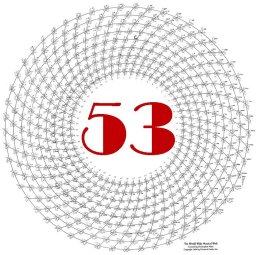Septimal Scales
*Easy*
You can create entire seven-note scales, both major and minor in affect, building from the septimal (based on the seventh harmonic) intervals we have listed above. To help the ear along, however, it may be easier to include a pure Pythagorean dominant in your scale. Indeed, Ptolemy and a handful of other theorists throughout history have created some scales which employ the seventh harmonic intervals in this very way.
These scales are incredibly evocative and have only rarely been used in modern times. Harry Partch’s “Two Studies” are a great example of a major composer’s work with some of these scales. https://www.youtube.com/watch?v=GIOZ-nnsaGQ Most of these septimal scales maximize the three-limit intervals (from C to F, G and D) because there are fewer consonances between the fifth harmonic (just thirds and sixths) than there are with the seventh harmonic. However, the seventh of the fifth, which as we said creates an F’ and clashes with the perfect fourth, can be at least considered for the fourth step of a septimal scale.
Figure 14-3 septimal scales
The first two examples are (4:02-4:11) Allaudin Mathie’s “blu” pentatonic scale, with septimal minor thirds and sixths, and a spine of fifths with their septimal sevenths on top of each note in the spine:
If you would like to learn more about this chapter, “Septimal Scales and Seventh Chords,” complete with all the different kinds of seventh chords and seventh-harmonic ancient scales, you can buy the entire book, The Grand Unified Theory of Music, in pdf form for $25 with hundreds of embedded musical examples of scales and chords from all over the world.
A free introduction to what The Grand Unified Theory of Music offers is on this website and includes both text and a few musical examples from each webpage. If you would like to learn more about this chapter and the full contents of this entire e-book, you can buy The Grand Unified Theory of Music for $25, with hundreds of embedded musical examples of scales and chords from all over the world — and ideas for how to set up your computer system —
HERE.
You’ll get a personalized password you can use to see the entire e-book. Inside the full book, you will also get a link to the complete pdf file of this e-book, which you can read on your Kindle or similar device. The links to the hundreds of mp3 sound files – the same ones you can hear on the website — will also be included. This is “Version 1.0” of The Grand Unified Theory of Music. Because it is an e-book, additions, corrections and improvements in the sound may be added at any time. The Grand Unified Theory of Music is Copyright © 2018 by Christopher Mohr. All rights reserved.
One person per password. Sharing this password with others is a violation of copyright. Do not allow others to use your password or link to the pdf file!

